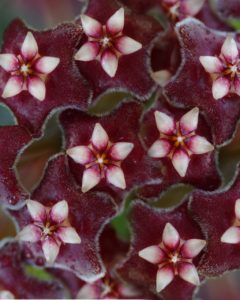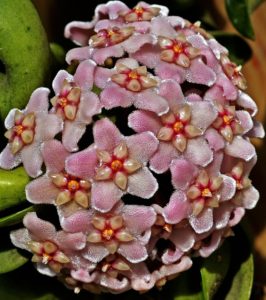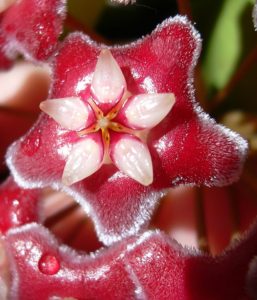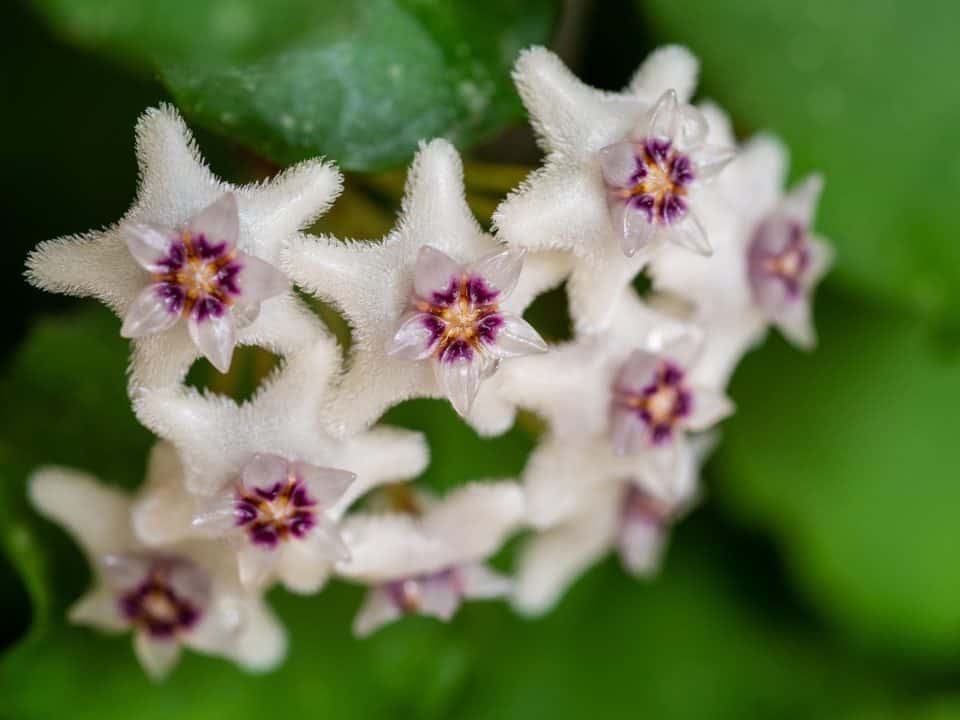Some links in the post are affiliate links and I get a commission from purchases made through some links found in the post.
Hoya is a common household plant and it comes in several different varieties. It is usually called Wax Plant.
It isn’t difficult to grow at all but common problems that you might face are fungal leaf spots or shriveled leaves on your hoya.
Don’t worry because we have got you covered and have listed all the information you need to make your plant green and healthy again!
What is a Hoya Plant?
 Native to Eastern Asia and Australia, the Hoya plant is a member of the family Apocynaceae. Its botanical name is Hoya carnosa.
Native to Eastern Asia and Australia, the Hoya plant is a member of the family Apocynaceae. Its botanical name is Hoya carnosa.
This plant has commonly been called wax plant as well as the wax vine and porcelain flower.
The leaves and flowers of this plant are covered with a thin cuticular layer of wax, giving them a glossy appearance, and thus, accounting for its common name.
This semi-woody vine plant has small oval leaves. It flowers in the spring to late summertime.
The small star-shaped flowers appear in a cluster of 10-50. The flowers range in color from pinkish white to dark pink.
The hoya plant grows best in bright natural light. It should be placed in a bright window but avoid too much harsh sunlight as it can get sunburned by excess.
If your hoya plant is struggling due to light, trying using this to help regulate the lighting.
It prefers a well-drained to almost completely dry soil. Overwatering can damage the plant. So be cautious not to flood your plant with too much water.
It needs a water-soluble houseplant fertilizer every month in the summers. It grows well in moderate humidity.
Try this easy to use fertilizer to give your plant that little boost.
What is Fungal Leaf Spots on Hoya?
Leaf spot is a disease caused by airborne fungal spores. They appear as small, round black, or brown dots.
These may spread across the plant if not checked and controlled. The spots can cause the leaves to shed. These spots can eventually damage the plant so much that the plant can die.
Spotting can be red, brown, black, red, white, or yellow. Brown to black spotting is mostly due to fungal and bacterial infestation.
Red spotting is the result of sunburns, yellow spotting due to nitrogen deficiency, and white spotting due to either mineral deposition or mealy bugs.
Fungal leaf spots are caused by a variety of fungi. You should look out for the following fungi that can severely damage your hoya plant:
1) Botrytis
The most common fungus affecting hoya plants is Botrytis cinerea commonly called “grey mold”.
It first causes spotting, then makes the leaves squishy and sloppy. It causes graying along the edges of the leaves.
The leaves eventually fall, and the spotting extends to other parts of the plant.
2) Septoria
Septoria lycopersici affects many different plants. It is especially known for causing spots on tomatoes.
Hoya Plant gets spotting when infected by this fungus. It can also cause the margins of the leaves to turn brown. If the infection becomes severe, the spots become larger and turn yellow.
3) Colletotrichum
Colletotrichum lagenarium is a common fungus of tropical regions and affects the hoya plant as well. It causes a disease called anthracnose.
It causes initially yellow spots which then progress to brown spots. This disease is infectious and can also spread to other plants.
4) Alternaria
Alternaria species cause black and brown spotting on the leaves of a hoya plant.
It also causes lesions on the stems of the plant. It is a common and severely damaging fungus.
How to Treat a Hoya with Fungal Leaf Spots
Take care of the respective steps to save your Hoya Plant from fungal leaf spots:
1) Isolate the Diseased Plant
If a single plant in your garden is diseased, isolate it immediately. This will prevent the fungus from spreading to the neighboring healthy plants.
2) Remove Diseased Leaves
Prune the leaves affected by the spotting. Clip those leaves which are extensively damaged. This would limit the spread of the fungus on the same plant.
3) Maintain Proper Lighting
The plant requires bright natural light. Depriving them of light encourages fungal growth. Place the plant where it will get adequate bright sunlight to remove the fungus.
4) Apply Organic Compost
For botrytis infection, apply organic compost to the soil. This prevents the leaves from regaining the fungal spores from the soil.
However, avoid mulching around the base of the plant. This can cause the accumulation of moisture and worsen the fungal disease.
5) Remove Suspected Soils
Remove any suspected soils harboring fungi. Use a new soil mix and repot the plant in it. Septoria fungi in particular stay dormant inside soils and can affect any new plants.
6) Keep Your Plant Dry
 Watering in moderation helps your plant to stay healthy. Water the plant whenever the soil feels excessively parched and completely dried up.
Watering in moderation helps your plant to stay healthy. Water the plant whenever the soil feels excessively parched and completely dried up.
Normally, it would require watering frequently in the summers because of the heat. In winters, it does not require that much watering.
Excess watering provides damp conditions suitable for fungus. So, keep it as dry as it can tolerate preventing infections.
7) Improve Air Circulation
Place your hoya plant in a well-aerated and ventilated environment and do not overcrowd the plants.
Maintaining proper air circulation prevents it from getting reinfected by the fungus and causes it to remain dry.
8) Apply Fungicides
Apply copper or sulfur-based fungicides. Mix the fungicide in water and spray it over the leaves. This would kill the infecting fungus.
A natural fungicide to aid you is cinnamon. Use cinnamon powder on the affected plant to get rid of the fungus.
Why are my Hoya Plant Leaves Shriveling?
If your Hoya Plant leaves are curling, shriveling, and wrinkling, it may be due to a number of factors. The common factors your plant may be facing are:
1) Water Stress
Hoya Plant being a succulent plant does not require a lot of water. This doesn’t mean you should get carried away and not water it for a month.
Underwatering can cause the leaves to curl and shrivel. The plant will dehydrate, and the leaves will not get proper nutrition.
The soil should be near to dry but should not be completely parched. Once the soil dries up water it to a well-drained moist condition.
If you’re not underwatering your plant, then check for root damage. Damaged roots fail to absorb the water and cause the plant to dry up.
A more severe factor that could be the cause of the shriveled leaves is overwatering.
Overwatering may be due to inadequate drainage of the soil or frequent watering. As discussed, water only per requirement. This will prevent fungal infections as well as shriveling.
If you need help watering your plant, try using this automatic drip irrigation kit.
2) Pest Problems
Rarely, infestation by mealybugs or aphids can cause your hoya plant leaves to shrivel. The insects feed on the leaves, suck their water and cause them to dry out.
To solve this problem, clean the leaves, isolate the infected plant and use a neem oil spray at night. This would prevent future infestations.
3) Temperature Shock
Hoya plant prefers warm conditions to grow particularly temperatures between 60 °F and 80 °F.
If you displace the plant from its position to an environment with too warm or too cold a temperature, the plant may go into a state of shock and the leaves can shrivel up.
The leaves don’t shrivel when grown indoors, where the temperature doesn’t fluctuate much. This keeps it safe from temperature shocks.
If you enjoyed this article check out, how to care for your peperomia frost plant.
Final Thoughts: How to Treat a Hoya with Fungal Leaf Spots
 Hoya plants are beautiful plants that add life add vibrancy to any tropical garden.
Hoya plants are beautiful plants that add life add vibrancy to any tropical garden.
Even though they are quite easy to grow and low maintenance, they do require some extra care when it comes to certain fungal diseases.
If you’ve made it this far, then hopefully all your questions regarding your precious plant have been dealt with.
About the Author:
Saad Ansar
Saad is an avid gardener himself and is a great lover of plants, animals, photography, & people. Currently, he is focused on photographing indoor plants & captioning beautiful outdoor sceneries. He writes and rewrites in-depth articles on nature and science.

